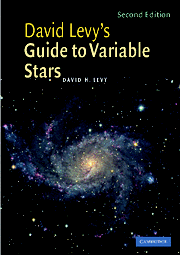Book contents
- Frontmatter
- Contents
- Foreword to the first edition
- Preface
- Acknowledgments
- Part I Getting to know the sky
- Part II Getting to know the variables
- 5 Meeting the family
- 6 Getting started with Cepheids
- 7 Algol, the demon of autumn
- 8 How to estimate a variable
- 9 Names and records
- 10 How your observations help us understand a variable star
- 11 Observing hints
- 12 Observing with CCDs
- 13 Stately and wonderful
- 14 Stars of challenge
- 15 Bright, easy, and interesting
- 16 Betelgeuse: easy and hard
- 17 Not too regular
- 18 Nova? What nova?
- 19 Supernovae
- 20 Clyde Tombaugh's star and the family of cataclysmic variables
- 21 A nova in reverse?
- 22 RU Lupi?
- 23 Orion, the star factory
- 24 Other variable things
- 25 The Sun
- Part III Suggested variables for observation throughout the year
- Part IV A miscellany
- Index
25 - The Sun
from Part II - Getting to know the variables
Published online by Cambridge University Press: 05 August 2012
- Frontmatter
- Contents
- Foreword to the first edition
- Preface
- Acknowledgments
- Part I Getting to know the sky
- Part II Getting to know the variables
- 5 Meeting the family
- 6 Getting started with Cepheids
- 7 Algol, the demon of autumn
- 8 How to estimate a variable
- 9 Names and records
- 10 How your observations help us understand a variable star
- 11 Observing hints
- 12 Observing with CCDs
- 13 Stately and wonderful
- 14 Stars of challenge
- 15 Bright, easy, and interesting
- 16 Betelgeuse: easy and hard
- 17 Not too regular
- 18 Nova? What nova?
- 19 Supernovae
- 20 Clyde Tombaugh's star and the family of cataclysmic variables
- 21 A nova in reverse?
- 22 RU Lupi?
- 23 Orion, the star factory
- 24 Other variable things
- 25 The Sun
- Part III Suggested variables for observation throughout the year
- Part IV A miscellany
- Index
Summary
Variation of the Sun! For many years the AAVSO has had a section for observation of the Sun, the logic being the star around which we revolve is a variable. In a stretched sense this may be true, but if we were to observe the Sun as we watch other stars, from light years away, we would find it shining at a constant brightness, without any indication whatsoever of its 11-year cycle of variation that we see manifested in sunspot activity.
Whether we worship it, plan our lives by its schedule, tan ourselves by its light, bask in its warmth, or study it, the Sun is a star whose importance cannot be overstated. And when we observe it through our telescope, we learn much about the the churning, changing nature of the star around which our planet turns.
An amateur astronomer and pharmacist of Dassau, Germany, Heinrich Schwabe, discovered the Sun's “variation” in 1843 through his long series of meticulous observations of its activity. After buying a small telescope, he began to search for a planet inside Mercury's orbit, hoping to find it transiting the Sun's surface. This “Vulcan” idea still lives and, as late as 1982, infrared searches have attempted to find such a planet. It has not been found. Schwabe's serendipitous discovery was the 11-year sunspot cycle.
The most obvious solar feature is the sunspots, magnetic storms on the solar surface that appear dark because they are cooler than the rest of the surface.
- Type
- Chapter
- Information
- David Levy's Guide to Variable Stars , pp. 149 - 154Publisher: Cambridge University PressPrint publication year: 2005

